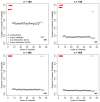Accounting for uncertainty in confounder and effect modifier selection when estimating average causal effects in generalized linear models
- PMID: 25899155
- PMCID: PMC4575246
- DOI: 10.1111/biom.12315
Accounting for uncertainty in confounder and effect modifier selection when estimating average causal effects in generalized linear models
Abstract
Confounder selection and adjustment are essential elements of assessing the causal effect of an exposure or treatment in observational studies. Building upon work by Wang et al. (2012, Biometrics 68, 661-671) and Lefebvre et al. (2014, Statistics in Medicine 33, 2797-2813), we propose and evaluate a Bayesian method to estimate average causal effects in studies with a large number of potential confounders, relatively few observations, likely interactions between confounders and the exposure of interest, and uncertainty on which confounders and interaction terms should be included. Our method is applicable across all exposures and outcomes that can be handled through generalized linear models. In this general setting, estimation of the average causal effect is different from estimation of the exposure coefficient in the outcome model due to noncollapsibility. We implement a Bayesian bootstrap procedure to integrate over the distribution of potential confounders and to estimate the causal effect. Our method permits estimation of both the overall population causal effect and effects in specified subpopulations, providing clear characterization of heterogeneous exposure effects that may vary considerably across different covariate profiles. Simulation studies demonstrate that the proposed method performs well in small sample size situations with 100-150 observations and 50 covariates. The method is applied to data on 15,060 US Medicare beneficiaries diagnosed with a malignant brain tumor between 2000 and 2009 to evaluate whether surgery reduces hospital readmissions within 30 days of diagnosis.
Keywords: Average causal effect; Bayesian adjustment for confounding; Confounder selection; Treatment effect heterogeneity.
© 2015, The International Biometric Society.
Conflict of interest statement
Figures


References
-
- George EI, McCulloch RE. Variable selection via gibbs sampling. Journal of the American Statistical Association. 1993;88:881–889.
-
- Greenland S, Robins JM, Pearl J. Confounding and collapsibility in causal inference. Statistical Science. 1999;14:29–46.
-
- Imai K, Van Dyk DA. Causal inference with general treatment regimes. Journal of the American Statistical Association. 2004;99:854–866.
-
- Imbens GW. Nonparametric estimation of average treatment effects under exogeneity: A review. Review of Economics and Statistics. 2004;86:4–29.
Publication types
MeSH terms
Grants and funding
LinkOut - more resources
Full Text Sources
Other Literature Sources

